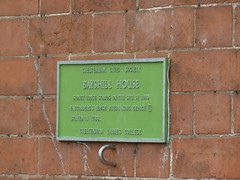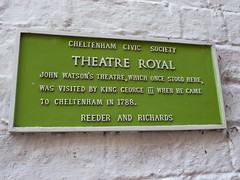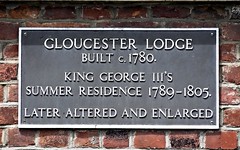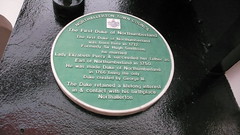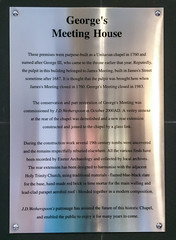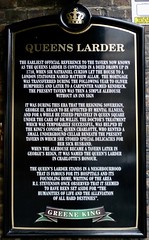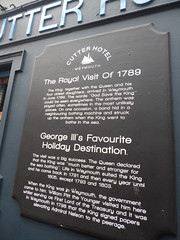King George III of Great Britain of the United Kingdom


King George III of Great Britain of the United Kingdom
(1738-1820)
3rd King of Great Britain (1760-1801), King of Ireland (1760-1801), and 1st King of the United Kingdom (1801-1820)
Family tree
Commemorated on 11 plaques
Bayshill House Sidney Lodge stands on the site of Lord Fauconberg's house where King George III stayed in 1788.
Overton Road, Cheltenham, United Kingdom where they stayed
Theatre Royal John Watson's theatre, which once stood here, was visited by King George III when he came to Cheltenham in 1788.
Grosvenor Terrace, Cheltenham, United Kingdom where they visited
The Old Well Here was a pathway to the old well where King George III took the waters in 1788. It was situated near the present Princess Hall.
Main entrance to Ladies’ College, Bayshill Road, Cheltenham, United Kingdom where they took the waters
Boulton and Watt Engine The oldest rotative steam engine in the world. Built in 1785, it powered Whitbread's London Brewary until 1887. James Watt demonstrated this engine to King George III when he visited the brewary in 1787. This engine marks the start of mass industrialisation and the exponential increase in our use of fossil fuel.
Powerhouse Museum, 500 Harris Street, Ultimo, Sydney, New South Wales, Australia where they visited
This hotel occupies the site of the old Royal Hotel which was used as public assembly rooms in the time of King George III
Royal Hotel, The Esplanade, Weymouth, United Kingdom where they visited
Gloucester Lodge built c. 1780. King George III's summer residence 1789-1805 Later altered and enlarged
Gloucester Lodge, The Esplanade, Weymouth, United Kingdom where they stayed (1788-1804)
The Kings Arms This historic 16th century inn had Georgian renovations in the 18th century and a Victorian attic in the 19th century. King George III stayed in Weymouth in 1789, on doctors orders. He was taken across the Esplanade by a horse drawn bathing machine and a small orchestra would play "God save the King" as he stepped into the water. Today the Kings Arms extends a Royal Welcome to One & All.
Kings Arms, 15-16 Trinity Road, Weymouth, United Kingdom where they stayed (1789)
The First Duke of Northumberland. The first Duke of Northumberland was born here in 1712. Formerly Sir Hugh Smithson, he married Lady Elizabeth Percy & succeeded her father as Earl of Northumberland in 1750. He was made Duke of Northumberland in 1766 being the only Duke created by George III. The Duke retained a lifelong interest in & contact with his birthplaces Northallerton.
High Street, Northallerton, United Kingdom where they connected in an unknown way
George's Meeting House These premises were purpose-built as a Unitarian chapel in 1760 and named after George III, who came to the throne earlier that year. Reputedly, the pulpit in this building belonged to James Meeting, built in James's street sometime after 1687. It is thought that the pulpit was brought here when James's Meeting closed in 1760. George's Meeting closed in 1983. The conservation and part restoration of George's Meeting was commissioned by J.D. Wetherspoon in October 2000AD. A vestry annexe at the rear of the chapel was demolished and a new rear extension constructed and joined to the chapel by a glass link. During the construction work several 19th century tombs were uncovered and the remains respectfully reburied elsewhere. All the various finds have been recorded by Exeter Archaeology and collected by local archive. The rear extension has been designed to harmonise with the adjacent Holy Trinity Church, using traditional materials - flamed blue-black slate for the base, hand-made red brick in lime mortar for the main walling and lead-clad parapet aerofoil roof - blended together in a modern composition. J.D. Wetherspoon's patronage has assured the future of this historic Chapel, and enable the public to enjoy it for many years to come.
South Street, Exeter, United Kingdom where they was
Queens Larder The earliest official reference to the tavern known as the Queens Larder is contained in a deed drawn up in 1710, when Sir Nathaniel Curzon let the house to a London stationer named Matthew Allan. The mortgage was transferred during the following year to Oliver Humphries and later to a carpenter named Kendrick. The present tavern was a simple alehouse without an inn sign. It was during this era that the reigning sovereign, George III, began to be effected by metal illness, and for a while he stayed privately in Queen Square under the care of Dr. Willis. The doctor’s treatment which was temporarily successful, was helped by the King’s Consort, Queen Charlotte, who rented a small underground cellar beneath the present tavern in which She stored special delicacies for her sick husband. When the alehouse became a tavern later in George’s reign , it was named the Queen’s Larder in Charlotte’s honour. The Queen’s Larder stands in a neighbourhood that is famous for its hospitals and its Foundling Home. Writing of the area R.I. Stevenson once observed that it seemed to have been set aside for “the humanities of life and the alleviation of all hard destinies”
1 Queen Square, London, United Kingdom where they was
Cutter Hotel Weymouth The Royal Visit of 1789 The King, together with the Queen and his four oldest daughters, arrived in Weymouth in June 1789. The words "God Save the King" could be seen everywhere. The anthem was played often. On one occasion, a band hid in a neighbouring bathing machine and struck up the anthem when the King went to bathe in the sea. George III's Favourite Holiday Destination. The visit was a big success. The Queen declared that the King was "much better and stronger for the sea bathing". Life in Weymouth suited the King and he came back in 1791 and then every year until 1805, except 1793 and 1803. When the King was in Weymouth, the government came to see him. William Pitt the Younger visted him here whilst serving as First Lord of the Treasury and it was in Weymouth in 1798 that the King signed papers elevating Admiral Nelson to the peerage.
Cutter Hotel - St Alban Street, Weymouth, United Kingdom where they visited (1788-1804)

